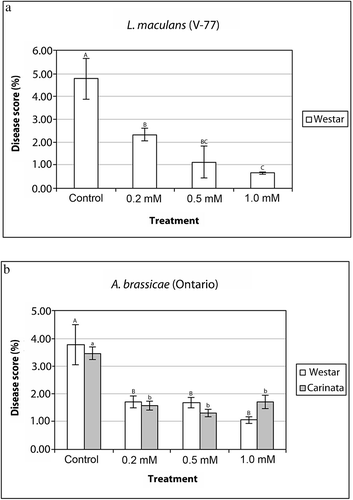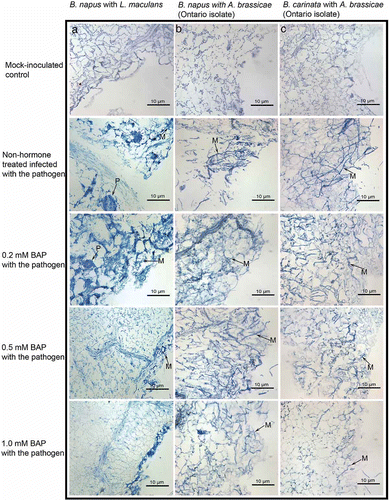Figures & data
Fig. 1. Disease symptoms induced by L. maculans and A. brassicae isolates on detached leaves of Brassica plants. a, Effects of various concentrations of BAP treatments on the disease severity score (%) induced by L. maculans on B. napus or b, by A. brassicae isolate UAMH 7476, and c, Ontario on B. napus and B. carinata. Data were analyzed by ANOVA (P < 0.05) and different letters on the histogram (capital letters for ‘Westar’; lower case for ‘Carinata’ plants) indicate significant (P < 0.05) differences for each plant line under different concentrations of hormone treatments.

Fig. 2. Severity of disease symptoms induced by L. maculans and A. brassicae (Ontario isolate) on whole leaves of Brassica plants. Effects of various concentrations of BAP treatments on the disease severity score (%) induced by a, L. maculans on B. napus, and b, by A. brassicae on B. napus and B. carinata. Data were analyzed by ANOVA (P < 0.05) and different letters on the histogram (capital letters for ‘Westar’; lower case for ‘Carinata’ plants) indicate significant (P < 0.05) differences for each plant line under different concentrations of hormonal treatments.

Table 1. Effect of cytokinins and other additives on colony growth of three phytopathogenic fungi
Fig. 3. Histological studies of responses of hormone-treated and untreated leaves of whole plants. Panels in (a) illustrate the effects of various concentrations of BAP on the interaction of B. napus (‘Westar’) leaves with L. maculans; with A. brassicae (Ontario isolate), (b); and B. carinata with A. brassicae (Ontario isolate), (c). The arrows with M indicate fungal mycelia, and P indicate pycnidia.
